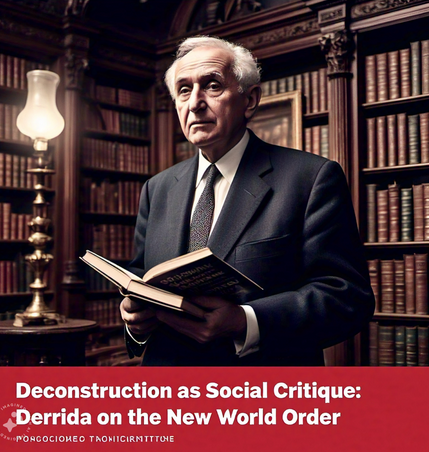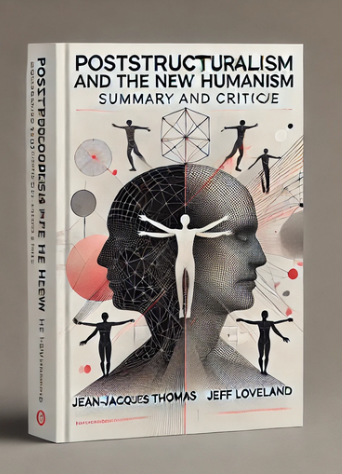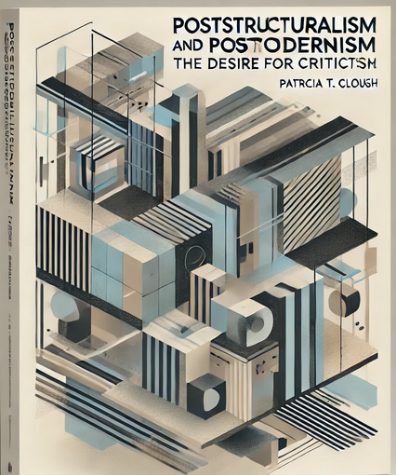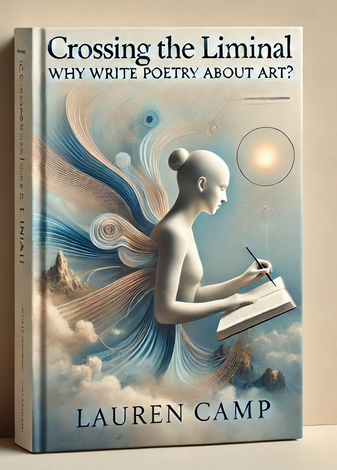
Introduction: “Deconstruction As Social Critique: Derrida On Marx And The New World Order” By Moishe Postone
“Deconstruction as Social Critique: Derrida on Marx and the New World Order” by Moishe Postone first appeared in History and Theory in 1998. The essay critically examines Jacques Derrida’s Specters of Marx, a seminal work that revisits Marx’s legacy in the context of global capitalism’s triumphalism following the Cold War’s end. Derrida introduces the concept of “spectrality,” which challenges the dominance of presentism and teleological narratives of history, emphasizing temporalities that transcend the immediate present. Postone critiques Derrida’s abstraction, arguing for a more historically grounded and socially specific analysis of capitalism’s dynamics. This work is crucial in literary theory for its intersection of deconstruction with Marxist critique, demonstrating how Derrida reinterprets Marx to address modern socio-political conditions. Postone’s critique advances the discourse by emphasizing the need for a critical theory that connects Derrida’s insights on temporality with tangible socio-historical analysis, contributing to debates on capitalism, justice, and the possibilities of emancipation in contemporary thought.
Summary of “Deconstruction As Social Critique: Derrida On Marx And The New World Order” By Moishe Postone
Derrida’s Theoretical Intervention: Addressing the Post-Cold War Era
- Jacques Derrida’s Specters of Marx offers a critique of neoliberal triumphalism following the collapse of the Soviet Union and Marxism’s perceived death (Postone, 1998, p. 370).
- Derrida introduces the concept of spectrality to question the present order and calls for a new International to resist economic and political neo-liberalism (p. 371).
- His strategy critiques Marxism by separating a “spirit of Marx” from its dogmatic and ontological elements, emphasizing the emancipatory potential of Marx’s ideas (p. 372).
Spectrality: Temporal Disjunctures and the Critique of Presentism
- Derrida’s concept of spectrality highlights non-identical temporalities, contrasting the “chain of presents” with the lingering impact of the past and aspirations for a different future (p. 373).
- Spectrality serves as a political framework to critique homogeneous time and presentism while advocating justice that transcends calculative systems rooted in vengeance (pp. 373-374).
Justice and Responsibility: Beyond Traditional Politics
- Derrida connects spectrality to a messianic notion of justice, opposing traditional notions of law and vengeance by envisioning justice as tied to the otherness of the future (pp. 375-376).
- This critique underpins his advocacy for a politics that breaks with the present, emphasizing memory and responsibility to the past and future victims of systemic injustices (p. 374).
Marx’s Legacy and Neo-Liberal Critiques
- Derrida frames his critique in opposition to neo-liberal ideologies like Fukuyama’s End of History, which celebrates capitalism as history’s culmination (pp. 376-377).
- He emphasizes the failures of neoliberalism through the “ten plagues” of the new world order, including unemployment, economic inequality, and international crises, asserting that global capitalism exacerbates oppression (pp. 378-379).
Spectrality and Marxism: Tensions and Limitations
- Derrida’s appropriation of Marx centers on the tension between Marxism’s emancipatory potential and its ontological rigidity (p. 380).
- He critiques traditional Marxist teleology and its presentism, arguing for a critique that integrates the spectral’s disruption of historical continuity (pp. 380-381).
Postone’s Critique of Derrida: Social and Historical Determinacy
- Postone argues that Derrida’s spectrality lacks historical specificity and cannot adequately critique global capitalism’s structural dynamics (p. 383).
- A meaningful critique, according to Postone, requires grounding in historically determinate categories like Marx’s analysis of capitalism as a system of social mediation, not just abstract concepts like spectrality (pp. 384-385).
The Need for a Reflexive Social Theory
- Postone critiques Derrida for failing to link his critique of neoliberalism to a self-reflexive theoretical framework that explains capitalism’s historical dynamics (p. 386).
- He suggests that Derrida’s approach risks affirming the same presentism it seeks to critique, as it does not provide the conceptual tools for imagining a determinate, emancipatory future (p. 387).
Conclusion: Toward a More Grounded Critical Theory
- While Postone acknowledges Derrida’s important critique of neoliberal triumphalism and traditional Marxism, he calls for a more historically and socially specific approach.
- This critique should articulate a determinate possibility for transformation within the current system, integrating Derrida’s insights with Marx’s historical materialism to address contemporary global challenges effectively (p. 387).
Theoretical Terms/Concepts in “Deconstruction As Social Critique: Derrida On Marx And The New World Order” By Moishe Postone
| Term/Concept | Definition/Explanation | Context/Usage in the Text |
| Spectrality | Refers to temporalities that transcend the present, including the persistence of the past and anticipation of the future. | Central to Derrida’s critique of presentism and as a means to reframe Marx’s legacy beyond traditional Marxism (Postone, 1998, pp. 372-374). |
| Presentism | The dominance of the immediate present as an immutable order, disregarding historical continuity and future potentialities. | Critiqued by Derrida as a barrier to imagining alternative futures and justice beyond the present (pp. 373-374). |
| Justice Beyond Right | A conception of justice removed from the logic of equivalence and vengeance inherent in law and politics. | Derrida contrasts this notion of justice with Heidegger’s metaphysics of presence (pp. 375-376). |
| Messianic | A concept of hope and redemption without concrete content or teleological determinism. | Derrida uses this to propose a politics of responsibility that embraces the spectral future (pp. 375-377). |
| New International | A network of non-governmental, non-party organizations and movements addressing global injustices. | Proposed by Derrida as a practical realization of his spectral politics, breaking from traditional Marxist organizational forms (p. 378). |
| Neo-Liberalism | An economic and political ideology characterized by market supremacy, individualism, and the dismissal of Marxist critiques. | Critiqued by Derrida as triumphalist and dismissive of the socio-economic inequalities it perpetuates (pp. 376-377). |
| Commodity Fetishism | The attribution of social relations to commodities, obscuring the underlying labor dynamics. | Derrida critiques Marx’s analysis of fetishism for privileging “presence” over spectral dimensions (p. 384). |
| Homogeneous Time | A linear, modular conception of time where each present moment is identical and disconnected from alternative temporalities. | Critiqued by Derrida as a feature of capitalist modernity and teleological history (pp. 373-374). |
| Ontology vs. Hauntology | Ontology refers to the study of being, while hauntology emphasizes the persistence of the spectral and non-present. | Derrida contrasts hauntology with traditional metaphysics of presence, incorporating spectrality (pp. 372-373). |
| Teleological Eschatology | A historical narrative where events are directed toward an inevitable end or resolution. | Derrida critiques both Marxist and neo-liberal ideologies for relying on such deterministic frameworks (p. 380). |
| Abstract Domination | A historically specific form of compulsion mediated by abstract social relations, particularly labor. | Used by Postone to critique Derrida’s lack of engagement with the structural dynamics of capitalism (p. 385). |
| Heteronomy | The subjection to external forces or laws rather than self-determination. | Postone links this to the domination inherent in capitalism, which Derrida overlooks (p. 386). |
| Reflexivity | A critique that grounds its theoretical categories in the historical and social conditions it seeks to analyze. | Postone argues that Derrida’s spectrality lacks reflexive grounding in empirical analysis (pp. 386-387). |
| Totality | A concept that critiques systemic, overarching structures, often seen as homogenizing or deterministic. | Postone reclaims totality as a critical object, diverging from Derrida’s rejection of it (pp. 386-387). |
Contribution of “Deconstruction As Social Critique: Derrida On Marx And The New World Order” By Moishe Postone to Literary Theory/Theories
1. Expanding Deconstruction into Socio-Political Critique
- Postone demonstrates how Derrida extends deconstruction beyond its textual roots to critique global capitalism and neoliberalism.
- By incorporating spectrality, Derrida critiques presentism, challenging fixed narratives of history and emphasizing non-linear, discontinuous temporalities (Postone, 1998, pp. 372-374).
- This approach aligns deconstruction with political theory, making it relevant for critiques of modern socio-political structures.
2. Challenging Traditional Marxism through Deconstruction
- Postone highlights Derrida’s critique of ontological and dogmatic Marxism, separating the “spirit of Marx” from its institutionalized forms (p. 372).
- Derrida’s work redefines Marxism, linking it to the hauntology of justice and emphasizing the emancipatory potential of Marx’s ideas over deterministic or teleological interpretations (pp. 375-377).
3. Contribution to Poststructuralism
- Derrida’s focus on justice beyond right and his critique of teleological eschatology contribute to poststructuralist debates on law, ethics, and governance (p. 376).
- His messianic hope introduces a non-content-based promise of transformation, reinforcing poststructuralist skepticism of grand narratives (p. 375).
4. Integrating Philosophy with Critical Social Theory
- Derrida bridges the gap between critical social theory and philosophy, as his critique of global capitalism addresses material inequalities alongside metaphysical concerns (pp. 376-378).
- This synthesis expands the relevance of literary theory to empirical and historical contexts, emphasizing the political implications of theoretical discourse.
5. Critique of Metaphysics and Homogeneous Temporality
- Derrida’s deconstruction of metaphysics of presence—such as substance, essence, and teleology—intersects with literary theory by challenging the fixity of narrative structures and time (pp. 373-374).
- Postone expands this critique by highlighting the failure of traditional Marxist and neoliberal ideologies to break from such metaphysical constructs (p. 380).
6. Influence on Hauntology in Contemporary Theories
- Derrida’s hauntology redefines notions of being and presence, offering a framework for analyzing absence, loss, and deferred futures (p. 372).
- This concept influences literary theories dealing with memory, temporality, and postcolonial studies, which grapple with the spectral persistence of historical injustices.
7. Renewing Marxist Literary Criticism
- Postone situates Derrida’s reinterpretation of Marx as a critique of commodity fetishism, showing its relevance to understanding the cultural production and consumption under capitalism (pp. 384-385).
- Derrida’s approach reinvigorates Marxist criticism by addressing how social relations are mediated and mystified in cultural texts.
8. Critique of Totality in Structuralism
- By rejecting structuralist totality, Derrida aligns with poststructuralism, proposing a fragmented, spectral alternative that allows for the coexistence of multiple temporalities (pp. 386-387).
- This critique is vital for literary theories focusing on decentered subjectivities and non-linear narratives.
9. Influence on Postmodern and Postcolonial Theories
- Derrida’s emphasis on the New International—a decentralized, non-hierarchical movement—provides a model for postmodern theories that resist traditional power structures (pp. 377-378).
- His critique of presentism and emphasis on spectral justice also resonate with postcolonial theories, which address the lingering effects of colonial histories (p. 375).
Examples of Critiques Through “Deconstruction As Social Critique: Derrida On Marx And The New World Order” By Moishe Postone
| Literary Work | Key Themes in the Work | Critique Using Postone/Derrida’s Framework |
| William Shakespeare’s Hamlet | Themes of justice, revenge, and the spectral presence of the past. | – The ghost of King Hamlet can be analyzed through spectrality, representing unresolved past traumas and the non-contemporaneity of the present (Postone, 1998, p. 374). – Hamlet’s existential struggle with time and justice aligns with Derrida’s critique of presentism and justice beyond right (p. 375). |
| Charles Dickens’ Hard Times | Critique of industrialization and dehumanizing effects of capitalism. | – The commodification of labor and reduction of individuals to economic functions parallels Derrida’s critique of commodity fetishism (p. 384). – The work can be viewed as critiquing the homogeneous time of industrial capitalism, which erases individuality and historical complexity (p. 373). |
| Franz Kafka’s The Trial | Bureaucratic oppression, alienation, and the elusive nature of justice. | – The opaque and unreachable justice depicted in The Trial resonates with Derrida’s notion of justice beyond right and the limits of institutionalized systems (p. 375). – The protagonist’s entrapment within an abstract system reflects abstract domination inherent in capitalist modernity (p. 386). |
| Toni Morrison’s Beloved | Memory, trauma, and the spectral presence of slavery’s legacy. | – The figure of Beloved as a ghost embodies spectrality, representing the lingering past that shapes present and future realities (p. 374). – Morrison’s focus on the intergenerational trauma of slavery aligns with Derrida’s critique of presentism and the need to confront historical injustices (p. 375). |
Criticism Against “Deconstruction As Social Critique: Derrida On Marx And The New World Order” By Moishe Postone
1. Lack of Empirical Grounding
- Postone critiques Derrida’s approach for being too abstract and socially indeterminate, failing to link spectrality to concrete historical and social dynamics (Postone, 1998, pp. 384-385).
- Derrida’s descriptive critique of neoliberalism (e.g., the “ten plagues”) lacks a framework to explain the interrelatedness of these phenomena (p. 379).
2. Insufficient Reflexivity
- The work lacks a self-reflexive critique that grounds its theoretical categories in the material conditions it seeks to address, undermining its relevance to real-world analyses (p. 386).
- Derrida avoids addressing how his critique relates to Marx’s historically specific categories, such as labor and capital, leading to theoretical vagueness (pp. 386-387).
3. Overreliance on Spectrality
- The concept of spectrality, while innovative, is criticized for being too broad and undifferentiated, making it insufficient to analyze specific forms of domination or historical patterns (pp. 385-386).
- Spectrality fails to distinguish between the reconstitution of present time and its undermining, which are critical for understanding systemic changes (p. 386).
4. Misreading of Marx
- Postone argues that Derrida misinterprets Marx’s critique, conflating it with traditional Marxist teleology and ontology (p. 384).
- Derrida’s reading of Marx through phenomenological lenses leads to a reductionist critique, ignoring Marx’s emphasis on historically specific forms of social relations (p. 385).
5. Overemphasis on Philosophy
- Postone contends that Derrida’s critique remains philosophically bound, limiting its capacity to address socio-economic realities and material conditions effectively (p. 387).
- The focus on deconstructing metaphysical categories neglects the structural and systemic dynamics of global capitalism (pp. 384-385).
6. Weak Engagement with Capitalism’s Dynamics
- Derrida’s critique does not sufficiently analyze the historical dynamic of capitalism, such as its mechanisms of exploitation and accumulation (p. 379).
- By relying on abstract notions like hauntology, Derrida risks reinforcing the same presentism and totality he seeks to dismantle (p. 386).
7. Theoretical Inconsistencies
- Derrida’s rejection of historical teleology conflicts with his use of Marx’s emancipatory spirit, creating a tension between messianic hope and historical materialism (pp. 375-377).
- Postone highlights that Derrida juxtaposes elements of Marxist analysis with deconstruction without adequately reconciling their differences (p. 384).
8. Limited Practical Applicability
- Derrida’s proposal of a New International, while conceptually intriguing, lacks specificity regarding how such movements would operate or achieve systemic change (p. 378).
- The absence of practical strategies for confronting global capitalism weakens the political utility of Derrida’s critique (p. 387).
Representative Quotations from “Deconstruction As Social Critique: Derrida On Marx And The New World Order” By Moishe Postone with Explanation
| Quotation | Explanation |
| “Spectrality entails temporal disjuncture; it expresses that which does not exist solely in the ‘chain of presents’.” (Postone, p. 379) | This highlights Derrida’s notion of spectrality as a challenge to presentism and linear conceptions of history, emphasizing the role of the past and future in shaping the present. |
| “Never have violence, inequality, exclusion, famine, and … economic oppression affected as many human beings.” (p. 85) | A critique of neoliberalism’s global impact, this emphasizes the failures of liberal democracy and capitalism to address escalating inequality and systemic crises. |
| “Derrida’s concept of spectrality provides a critique of the present in the name of another future and a justice beyond presence.” (p. 384) | Postone identifies how Derrida’s spectrality challenges conventional notions of justice, aiming for a form of justice not rooted in presentist vengeance or legal equivalence. |
| “Derrida asserts that there will be no future without the memory and inheritance of Marx, or at least one of his several spirits.” (p. 13) | Derrida insists on the necessity of Marx’s critical legacy for imagining alternative futures, despite critiquing Marxism’s ontological and dogmatic tendencies. |
| “Derrida criticizes Marx’s critique of ghosts, specters, and mystification as being from the standpoint of living presence.” (p. 384) | Postone critiques Derrida’s interpretation of Marx, arguing it misrepresents Marx’s materialist critique by reducing it to a simplistic opposition of spirit and presence. |
| “The notion of a fundamentally different future must be rooted in the present, in its tensions, possibilities, and struggles.” (p. 380) | Postone argues that Derrida’s critique lacks the material grounding necessary for a transformative vision of the future. |
| “The ‘New International’ represents a movement beyond presence, without fixed forms such as party, state, or class membership.” (p. 378) | Derrida’s vision of a global resistance aligns with decentralized, fluid, and inclusive movements, rejecting hierarchical and rigid structures of traditional Marxism. |
| “The abstract messianic, unlike teleological or eschatological programs, remains without content or identifiable messiah.” (p. 28) | Derrida’s notion of a “messianic” critique avoids fixed end-states, contrasting it with deterministic visions of history while retaining emancipatory hope. |
| “The failure of Marxism stems from its grounding in forms of presence, such as organizations, parties, and states.” (p. 29) | Derrida critiques traditional Marxism for its inability to transcend structures tied to presentist and static modes of organizing, limiting its transformative potential. |
| “Marx’s categories must be understood as historically specific, not transhistorical or material.” (p. 381) | Postone stresses the importance of viewing Marx’s analysis as historically contingent, countering Derrida’s more abstracted interpretations. |
Suggested Readings: “Deconstruction As Social Critique: Derrida On Marx And The New World Order” By Moishe Postone
- Postone, Moishe. “Deconstruction as Social Critique: Derrida on Marx and the New World Order.” History and Theory, vol. 37, no. 3, 1998, pp. 370–87. JSTOR, http://www.jstor.org/stable/2505491. Accessed 25 Dec. 2024.
- Ross Benjamin, and Heesok Chang. “Jacques Derrida, the Last European.” SubStance, vol. 35, no. 2, 2006, pp. 140–71. JSTOR, http://www.jstor.org/stable/4152890. Accessed 25 Dec. 2024.
- McCormick, John P. “Derrida on Law; Or, Poststructuralism Gets Serious.” Political Theory, vol. 29, no. 3, 2001, pp. 395–423. JSTOR, http://www.jstor.org/stable/3072555. Accessed 25 Dec. 2024.
- Murthy, Viren. “Beyond Particularity and Universality: Moishe Postone and the Possibilities of Jewish Marxism.” Jewish Social Studies, vol. 25, no. 2, 2020, pp. 127–67. JSTOR, https://doi.org/10.2979/jewisocistud.25.2.05. Accessed 25 Dec. 2024.








